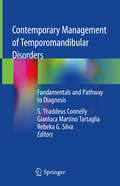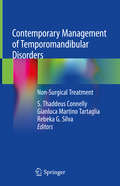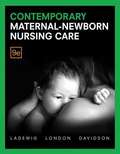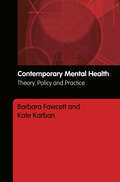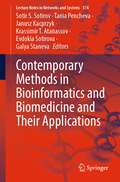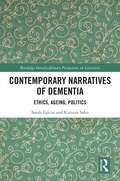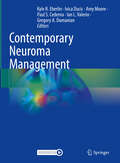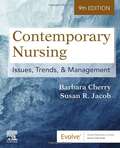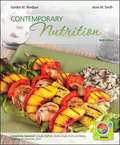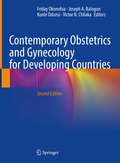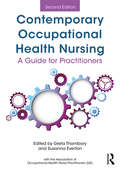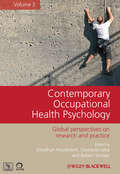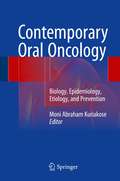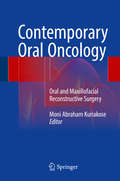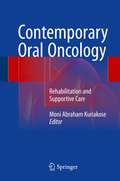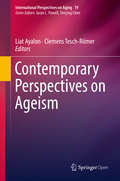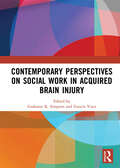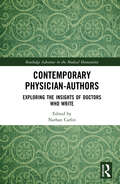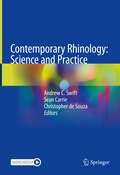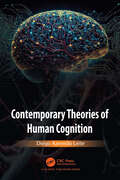- Table View
- List View
Contemporary Management of Temporomandibular Disorders: Fundamentals and Pathway to Diagnosis
by S. Thaddeus Connelly Gianluca Martino Tartaglia Rebeka G. SilvaThis book is a comprehensive, state of the art guide to the contemporary diagnosis of temporomandibular disorders (TMDs) that will help to compensate for the frequent lack of experience and inadequate training among health professionals who encounter patients with jaw joint problems. The opening section describes the whole patient philosophy essential for treatment success, examines ethical and legal considerations, and discusses all aspects of anatomy. Pathophysiology, clinical assessment, and imaging evaluation, including by means of modern MR imaging and CBCT, are then considered in detail. Finally, the diagnostic criteria for the full range of TMDs are thoroughly explained and the urgent need to appreciate temporomandibular disorders as the chronic pain conditions they are is addressed. Complementary volumes are devoted to non-surgical treatment of TMDs and to total temporomandibular joint replacement and other surgical procedures, respectively. Each book will be of high value for the multidisciplinary team necessary for successful management of TMDs, including dentists, surgeons, primary care doctors, pain doctors, and allied health professionals.
Contemporary Management of Temporomandibular Disorders: Surgical Treatment
by S. Thaddeus Connelly Gianluca Martino Tartaglia Rebeka G. SilvaThis book, in three volumes, is a comprehensive, state-of-the-art guide to the contemporary diagnosis and treatment of temporomandibular disorders (TMDs) that will help to compensate for the frequent lack of experience and inadequate training among health professionals who encounter patients with jaw joint problems. The first volume focuses on fundamentals and the pathways to diagnosis. Here, readers will find information on the whole patient philosophy, anatomy, pathophysiology, clinical and imaging evaluation, and diagnostic criteria. The second volume is devoted to non-surgical treatment of TMDs, covering medical and dental treatment, psychiatric considerations, and adjunctive therapies. In the final volume all aspects of total temporomandibular joint replacement and other surgical procedures are discussed, and the volume closes by examining the future of the field, including the use of bioengineered constructs. Key messages from the book are the vital role that recognition of TMDs as chronic pain conditions plays in successful management and the value of a multidisciplinary team approach involving dentists, surgeons, primary care doctors, pain doctors, and allied health professionals.
Contemporary Maternal-Newborn Nursing Care
by Marcia L. London Michele Davidson Patricia A. W. LadewigNOTE: Before purchasing, check with your instructor to ensure you select the correct ISBN. Several versions of Pearson's MyLab & Mastering products exist for each title, and registrations are not transferable. To register for and use Pearson's MyLab & Mastering products, you will also need a Course ID, which your instructor will provide. Used books, rentals, and purchases made outside of Pearson If purchasing or renting from companies other than Pearson, the access codes for Pearson's MyLab & Mastering products may not be included, may be incorrect, or may be previously redeemed. Check with the seller before completing your purchase. For 2- and 4-year college-level nursing courses that cover pregnancy, birth, and the postpartum period. Help readers think like maternal-newborn nurses Accurate, readable, and up-to-date, Contemporary Maternal-Newborn Nursing presents pregnancy and childbirth as normal life processes with family members as co-participants in care. This text thoroughly illuminates all aspects of maternal-newborn nursing and many opportunities for nurses to make a difference in a changing healthcare environment. After introducing key concepts, it progresses through the steps of the nursing process, clearly delineating nurses' roles throughout pregnancy, labor, birth, the newborn period, and postpartum care. For each, it presents basic theory followed by chapters on assessment and care for essentially healthy women or infants, and then by complications and treatment. Recurring themes include evidence-based practice, critical thinking, clinical decision-making, community-based care, patient and family teaching, safety, cultural competence, complementary/alternative therapies, and health promotion. This edition's significant updates include revisions reflecting the latest recommendations of AACN Baccalaureate Essentials, QSEN, the Institute of Medicine (IOM), and Healthy People 2020.
Contemporary Mental Health: Theory, Policy and Practice
by Barbara Fawcett Kate KarbanThe authors explore theoretical developments and policy and practice initiatives in the complex and changing area of mental health services. They examine the tensions, dilemmas and opportunities now operating, including those relating to gender and ethnicity and places the involvement of users/survivors centre stage.Identifying and discussing the tensions between different professional models, varying ‘social’ perspectives and political imperatives, the book explores how these tensions are manifested in practice. Key topics include: the emphasis on risk as opposed to citizenship and entitlement social exclusion and inclusion professional and user perspectives the ‘territories’ of health and social care and their respective roles and relationships. An important theme running throughout is the critical appraisal of perspectives concerning gender, ethnicity and sexuality, drawing out wider issues of power and inequality. This book makes ideas and theoretical policy material accessible and applicable, and is a key text for students and practitioners in mental health, social work and social care.
Contemporary Methods in Bioinformatics and Biomedicine and Their Applications (Lecture Notes in Networks and Systems #374)
by Krassimir T. Atanassov Janusz Kacprzyk Evdokia Sotirova Sotir S. Sotirov Tania Pencheva Galya StanevaThis book gathers selected papers from the First International Symposium on Bioinformatics and Biomedicine. Issues related to medicine and health care constitute one of the grand challenges faces by the mankind, and this naturally implies a growing interest in these problems among both researchers and scholars, politicians and policymakers, as well as economist. The present values which gather selected papers from the First International Symposium on Bioinformatics and Biomedicine (BioInfoMed’2020) is a recent response to this interests. In the subsequent sections and chapters, it covers a multitude of various topics related to bioinformatics, biomedicine, bioenginering, as well as a broadly perceives healthcare. Issues related to decision making in bioinformatics, biomedicine and health care, mathematical modelling in biomedicine and health care, artificial intelligence in biomedicine and health care, uncertainty and imprecision, notably intuitionistic fuzzy sets with applications in bioinformatics and biomedicine, biomedical approaches and applications, biomedical imaging and image processing, and excitable structures and motor activity are covered.
Contemporary Narratives of Dementia: Ethics, Ageing, Politics (Routledge Interdisciplinary Perspectives on Literature)
by Sarah Falcus Katsura SakoThis book examines narratives of dementia in contemporary literary texts, studying what is now a pressing issue with deep political, economic, and social implications for many ageing societies. As part of the increasing visibility of dementia in social and cultural life, these narratives pose ethical, aesthetic, and political questions about subjectivity, agency, and care that help us to interrogate the cultural discourse of dementia. Contemporary Narratives of Dementia is a seminal book that offers a sustained examination of a wide range of literary narratives, from auto/biographies and detective fiction, to children’s books and comic books. With its wide-reaching theoretical and critical scope, its comparative dimension, and its inclusion of multiple genres, this book is important for scholars engaging with studies of dementia and ageing in diverse disciplines. Sarah Falcus is a Reader in Contemporary Literature at the University of Huddersfield, UK. She has research interests in contemporary women’s writing, feminism and literary gerontology. She is the co-director of the Dementia and Cultural Narrative (DCN) network. Katsura Sako is an Associate Professor of English, at Keio University, Japan. Her main field of research is in post-war/contemporary British literature, and she has particular interests in gender, ageing and illness. She is a member of the steering committee of the DCN network.
Contemporary Neuroma Management
by Kyle R. Eberlin Ivica Ducic Amy Moore Paul S. Cederna Ian L. Valerio Gregory A. DumanianTraditional techniques for the surgical management of symptomatic neuromas involve excision with intra-muscular or intra-osseous burying. Over the last decade, a number of novel strategies have been developed that have led to a resurgence of interest in management of the symptomatic neuroma. These techniques are collectively summarized as active management strategies and include targeted muscle reinnervation (TMR), regenerative peripheral nerve interface (RPNI) and others. This comprehensive text provides a deep dive into the contemporary management of symptomatic neuromas. It discusses the diagnostic workup for neuropathic pain, including the use of imaging and diagnostic nerve blocks, and reviews the epidemiology and demographics of patients presenting with this problem. It then explores non-surgical modalities, as well as both traditional and novel surgical techniques, for the management of symptomatic neuroma. Part of the book is case-based and highlights these techniques, and can serve as a full-color atlas for the peripheral nerve surgeon. Contemporary Neuroma Management presents a concentrated, modern approach to the management of neuromas and will be utilized by peripheral nerve surgeons (plastic surgeons, neurosurgeons, orthopedic surgeons) as well as other pain management providers.
Contemporary Nursing: Issues, Trends, and Management
by Barbara Cherry Susan R. JacobWith an understanding of healthcare issues, you can improve patient care and advance the nursing profession! Contemporary Nursing: Issues, Trends, & Management, 9th Edition ensures that you are prepared for the complex and rapidly changing world of today’s nursing. <p><p>Coverage of key topics includes nursing theories and evidence-based practice, social and ethical issues, the rising cost of health care, quality improvement and patient safety, palliative care, effective decision-making, collective bargaining and unions, managing time, and career opportunities. Written by noted nursing educators Barbara Cherry and Susan R. Jacob, this text not only prepares you for the NCLEX-RN® examination, but for effective leadership and management in the workplace.
Contemporary Nursing: Issues, Trends, and Management (Seventh Edition)
by Barbara Cherry Susan R. JacobThoroughly prepare for the rapidly evolving world of nursing with Contemporary Nursing: Issues, Trends, & Management, 7th Edition. Expert authors Barbara Cherry and Susan Jacob combine their own expertise from both academics and practice as they cover the relevant issues affecting today's nurses. In 28 chapters, including a new chapter on palliative care, this comprehensive new edition takes readers through the evolution of nursing, the role of the nurse today, safe and effective decision-making, collaboration and communication, leadership, job opportunities, and a number of timely issues affecting healthcare and nursing practice today.
Contemporary Nutrition 9th Edition
by Gordon M. Wardlaw Anne M. Smith Angela Collene"Contemporary Nutrition" is a complete and balanced resource for nutrition information written at a level non-science majors can understand. Completely revised and up-to-date with MyPlate, Healthy People 2020 and Dietary Guidelines for Americans, 2010, it provides the ideal balance of reliable nutrition information and practical consumer-oriented knowledge. With a friendly writing style, the authors act as the student's personal guide to dispelling common misconceptions and to gaining a solid foundation for making informed nutrition choices. "Contemporary Nutrition" emphasizes that a population consists of individuals with varying genetic and cultural backgrounds, and these individuals will have varying responses to diet. The knowledge gained from this text will allow students to personalize nutrition information and empower them to make better choices in their daily lives.
Contemporary Obstetrics and Gynecology for Developing Countries
by Joseph A. Balogun Friday Okonofua Kunle Odunsi Victor N. ChilakaThis book is a comprehensive and easy-to-read guide to obstetrics and gynecology in developing countries. Although significant progress has been made towards the reduction of maternal mortality and morbidity globally, they are still unacceptably high in developing countries. This can be directly or indirectly tied to poor quality maternal health care and lack of access to cost-effective, comprehensive healthcare. Health practitioners in developing countries also contend with trying to keep abreast of recent developments in obstetrics and gynecology while dealing with lack of time, resources, and access to relevant information. This textbook was thus created by experts in obstetrics and gynecology with extensive experience in African clinical settings and consultants in developed countries to teach proper and accurate diagnosis, treatment and management of gynecologic and obstetric health issues within the context of developing countries.This second edition has been fully updated throughout with an added 25+ chapters that cover topics such as reproductive health, gynecological cancers and research methods. The book is divided into six sections: Women’s Reproductive Health; Obstetrics; Medical and Surgical Disorders in Pregnancy; General Gynecology; Gynecological Malignancies; Health Systems Organization, Research Methodology and Biostatistics. These section topics have been carefully covered by expert authors with the use of valid scientific data, policy instruments, and adapted to the cultural and social context of developing countries, with particular in depth coverage of conditions that have greater prevalence and incidence in developing countries. Each chapter also focuses on filling gaps in knowledge with a distinct pedagogical approach, starting with a set of learning objectives and ending with key takeaways for the chapter.This is an ideal guide for residents, medical students, practitioners of obstetrics and gynecology, midwives, general practitioners, and pediatricians, particularly those working in developing companies.
Contemporary Occupational Health Nursing: A Guide for Practitioners
by Greta Thornbory Susanna EvertonThis textbook – now thoroughly revised and updated – provides a practical guide for those in training, or practising within, occupational health nursing. Concerned with the health of people at work and the effects of work on health and health on work, this distinctive branch of public health nursing requires specific knowledge and skills. Contemporary Occupational Health Nursing includes chapters on: public health, leadership, health promotion and protection, health surveillance, health assessment, case management and rehabilitation, mental health, management of occupational health services and epidemiology and research, quality assurance and audit. The second edition includes additional content on health risk assessment and the Fit for Work Service, occupational health management systems, psychosocial factors and mindfulness, among other things. Discussion of ethical issues is woven throughout and each chapter is written by an experienced occupational health nurse practitioner and includes features such as case studies, activities, learning objectives and chapter summaries. This book can be used as a text by those undertaking specialist community public health nursing qualifications and as an important resource for all nurses working in occupational health practice.
Contemporary Occupational Health Psychology
by Stavroula Leka Robert R. Sinclair Jonathan HoudmontContemporary Occupational Health Psychology: Global Perspectives on Research and Practice, Volume 2 continues a definitive reference series published in association with the European Academy of Occupational Health Psychology (EAOHP) and the Society for Occupational Health Psychology (SOHP). The series summarizes state-of-the-art research and practice in the field of occupational health psychology.Volume 2 of the most important and influential research series in the rapidly growing field of occupational health psychologyPresents state-of-the-art research along with its implications for real-world practiceProvides in-depth reviews of hot topics, including new work from several top international experts in the fieldVolume 2 includes increased North American contributions, sourced by a dedicated North America editor
Contemporary Oral Oncology: Biology, Epidemiology, Etiology, and Prevention
by Moni Abraham KuriakoseThisis the first of four volumes that together offer an authoritative, in-depth reference guide covering all aspects of themanagement of oral cancer from a multidisciplinary perspective and on the basisof a strong scientific foundation. This volume,on tumor biology, epidemiology, etiology, emerging role of cancer stem cells andprevention of oral cancer, opens by discussing oral carcinogenesis in generaland the role of particular carcinogens and human papillomavirus. Globalepidemiology and changes in disease prevalence are then addressed. Up-to-dateinformation is provided on emerging cancer biomarkers, and the biologic basisof personalized therapy is explained. Histopathological features of malignantand premalignant neoplasms and their relevance to management are described. Further chapters focus on the current status of chemoprevention, the managementof oral submucous fibrosis, and the value of various diagnostic adjuncts. Thevolume concludes by critically evaluating the efficacy of oral screeningmethods.
Contemporary Oral Oncology: Diagnosis and Management
by Moni Abraham KuriakoseThisis the second of four volumes that together offer an authoritative, in-depth reference guide covering all aspects of themanagement of oral cancer from a multidisciplinary perspective and on the basisof a strong scientific foundation. This volume addressesa range of management issues in oral cancer, from imaging and staging throughto the roles of radiation therapy and chemotherapy. Principles of ablativesurgery are explained, and neck dissection and sentinel lymph node biopsytechniques, described. Detailed consideration is also given to the managementof complications, salvage surgery and re-radiation, the biologic basis oftreatment failure, and emerging approaches to overcome treatment resistance. The inclusion of resource-stratified guidelines will meet the needs of practitionersin different geographic regions with varying resources.
Contemporary Oral Oncology: Oral and Maxillofacial Reconstructive Surgery
by Moni Abraham KuriakoseThis book set, in four volumes, is an authoritative, in-depth reference guide that covers all aspects of the management of oral cancer from a multidisciplinary perspective and on the basis of a strong scientific foundation. Individual volumes are devoted to tumor biology, epidemiology, etiology, and prevention; diagnosis and treatment options; reconstructive surgical techniques; and rehabilitation and supportive care. By integrating current scientific knowledge into a manual for comprehensive care of the oral cavity cancer patient, the book will fill a substantial void in the literature. Further key features are thorough attention to the practical significance of emerging technology and the inclusion of contributions from authors in diverse geographic locations and practice settings in order to ensure that the guidance is of global relevance. The clearly written text is supported by ample illustrations and by case studies highlighting important practical issues. Volume 1: Biology, Epidemiology, Etiology, and Prevention Volume 2: Diagnosis and Management Volume 3: Oral and Maxillofacial Reconstructive Surgery Volume 4: Rehabilitation and Supportive Care
Contemporary Oral Oncology: Rehabilitation and Supportive Care
by Moni Abraham KuriakoseThis is the last of four volumes that together offer an authoritative, in-depth reference guide covering all aspects of the management of oral cancer from a multidisciplinary perspective and on the basis of a strong scientific foundation. This volume focuses on the topic of comprehensive rehabilitation and supportive care in oral cancer. The coverage includes the role of maxillofacial prosthodontics, advances in anaplastology techniques, and management of oral mucositis during radiation and chemotherapy. Holistic and supportive care approaches are discussed, and advice is provided on post-therapy surveillance and the use of different measures to assess quality of life. Nutritional evaluation and management and issues relating to healthcare economics are also considered. This volume will be of interest both to practicing specialists and to ancillary service staff involved in the care of oral cancer patients.
Contemporary Perspectives on Ageism (International Perspectives on Aging #19)
by Liat Ayalon Clemens Tesch-RömerTh is open access book provides a comprehensive perspective on the concept of ageism, its origins, the manifestation and consequences of ageism, as well as ways to respond to and research ageism. The book represents a collaborative effort of researchers from over 20 countries and a variety of disciplines, including, psychology, sociology, gerontology, geriatrics, pharmacology, law, geography, design, engineering, policy and media studies. The contributors have collaborated to produce a truly stimulating and educating book on ageism which brings a clear overview of the state of the art in the field. The book serves as a catalyst to generate research, policy and public interest in the field of ageism and to reconstruct the image of old age and will be of interest to researchers and students in gerontology and geriatrics.
Contemporary Perspectives on Social Work in Acquired Brain Injury
by Grahame K. Simpson and Francis YuenContemporary Perspectives is the first book to address social work practice in the field of brain injury (BI). Contributions are written by social work authors from around the world, and highlight the diversity of social work practice and theory within this field. Chapters range from practice spanning interventions with families caring for a child with BI; interventions to assist the adjustment of families facing the challenge of supporting an adult relative with BI during the inpatient rehabilitation or post-acute community phase; work with parents with BI who are caring for children deemed to be at risk; and a literature review outlining the impact of a BI on siblings. Other chapters detail a program for self-advocacy; investigate the impact of violence-related BI; evaluate a peer-support program for people with BI; report on the role of support people in facilitating return to work after BI; and examine the role of social work within the interdisciplinary rehabilitation team. The volume highlights the valuable role social work makes to the field of BI and contributes to the knowledge base informing evidence-informed practice within this field. This book was originally published as a special issue of the Journal of Social Work in Disability & Rehabilitation.
Contemporary Physician-Authors: Exploring the Insights of Doctors Who Write (Routledge Advances in the Medical Humanities)
by Nathan CarlinThis book examines the phenomenon of physician-authors. Focusing on the books that contemporary doctors write--the stories that they tell--with contributors critically engaging their work. A selection of original chapters from leading scholars in medical and health humanities analyze the literary output of doctors, including Oliver Sacks, Danielle Ofri, Atul Gawande, Louise Aronson, Siddhartha Mukherjee, and Abraham Verghese. Discussing issues of moral meaning in the works of contemporary doctor-writers, from memoir to poetry, this collection reflects some of the diversity of medicine today. A key reference for all students and scholars of medical and health humanities, the book will be especially useful for those interested in the relationship between literature and practising medicine.
Contemporary Research on Sex Work
by Jeffrey T. ParsonsGain important insight and a broader perspective on where, why, and how sex workers conduct their businessFor years, the focus of sex work research has been on street-based male and female sex workers and the HIV-related risks they pose to their clients. Contemporary Research on Sex Work moves beyond the basic association between sex work and unprotected sex to a fuller description of the varied facets of the industry while still pursuing a better understanding of HIV risk among those working the streets. The diverse approaches in this unique book include targeted sampling, qualitative and quantitative interviews, ethnographic interviews with key informants, using sex workers as recruiters, and quasi-experimental intervention designs.Contemporary Research on Sex Work dispels the notion that all sex workers are prostitutes working the streets, highlighting instead various aspects of sex work in terms of gender, venue, and context. Social scientists from a variety of disciplines present research collected from across the United States, Cambodia, the Philippines, Argentina, and Canada that reflects the efforts to explore interventions and programs designed to improve the social and physical lives of male, female, and transgender sex workers-and their clients. The book examines how different circumstances determine different issues of power, control, health, social functioning, mental health, and HIV/STI risk each sex worker faces.Contemporary Research on Sex Work examines: condom use by transgender female sex workers the association between mental health issues and unprotected sex the influence of structural intervention in reducing biologically sexually transmitted infections (STIs) the "hidden" population of women who solicit clients in private locations off the street stigma resistance among male sex workers in Canada the relationship between childhood sexual abuse and subsequent involvement in sex work health services among male sex workers in Argentina how the intersection between race/ethnicity affects female sex workers in Los Angeles how sex workers deal with the negativity that surrounds their profession job-related risk and safety for sex workers in Canada legal concerns and policy issues and much more!Contemporary Research on Sex Work is your guide to the next generation of sex work research, highlighting the need to understand sex work as work. The book is an essential resource for researchers in the fields of sex research, sex work, and HIV/AIDS prevention, and for clinicians who work with those involved in the industry.
Contemporary Rhinology: Science and Practice
by Christopher De Souza Andrew C. Swift Sean CarrieThis textbook includes the latest knowledge and advances for a comprehensive range of disorders, including the management of benign and malignant sinonasal tumours. Rhinology is now a fully established and highly popular specialist field that has undergone a major paradigm shift over recent decades. This progressive change has been possible because of the synchronous developments in technology, radiology, therapeutics and pharmacology. These advances have changed clinical practice in every dimension, and this has led to a truly global exponential rise in specialist rhinological interest into the management of sinonasal disorders.Contemporary Rhinology: Science and Practice opens with the basic science of rhinology, with chapters that build an understanding of the nose and sinuses. Chapters cover embryology, anatomy, physiology, immunology, sleep disorders, and more. From there, clinical assessment of the nose and sinuses is discussed. The following sections cover pediatric sinonasal disorders and inflammatory sinus disorders, such as pediatric rhinosinusitis, pediatric nasal deformity, allergic and non-allergic rhinitis, and fungal sinus disease. Following these are several chapters discussing tumors and sinus and skull base surgery. The textbook closes with coverage of a variety of smaller topics, such as epistaxis, trauma to the nose and paranasal sinuses, and nasal obstructions. The textbook features outstanding illustrations, video clips, and key points to enhance understanding and recall.This textbook’s balance of applied science and clinical practicality makes is an ideal resource for anyone from trainee surgeons to established specialists in rhinology.
Contemporary Skull Base Surgery: A Comprehensive Guide to Functional Preservation
by A. Samy YoussefThis text is designed to function as a comprehensive guide/companion that will not only facilitate the decision-making process for the surgeon, but also help young surgeons build a successful career in skull base surgery. It is divided into six main sections: The first section details the general principles that every skull base surgeon needs to be acquainted with - skull base anatomy, developing a multidisciplinary skull base team, operating room equipment, surgical instruments, and modern imaging technologies. These are the key elements that play a major role in optimizing functional outcomes and patients’ quality of life. Following this, the compartmental anatomy chapters set the stage for understanding the technical and surgical nuances of each location. The subsequent five sections are organized as anatomical compartments or regions of the skull base. Every region is organized in the same format for uniformity and ease of use. Each section includes the available treatment choices to each compartment, and describes the relevant pathologies. The contribution of worldwide leaders including neurosurgeons and otolaryngologists provides top-level expertise in how to tackle each pathology. The surgical approaches chapters that lead each anatomical section describe operative techniques in a clear. stepwise fashion with accompanying intra-operative photos and surgical videos. In the individual pathology chapters, different pathological subtypes are described with representative radiographic images of clinical case examples. Accompanying each pathology is a treatment algorithm based on tumor morphology, pre-operative clinical status, and the goal of maximum functional preservation with a brief description of surgical approaches. This will serve as a roadmap that will help the reader to easily reach a decision of how to treat each skull base pathology. The general theme is functional and anatomical preservation of key neurovascular structures. Setting such structures as a target and planning an approach that minimizes iatrogenic damage to these structures will lead the surgeon down the road of either open, endoscopic, or a combination of both approaches. A comprehensive book that is versatile to serve as a handbook as well as a detailed reference for skull base surgery does not currently exist. In addition, combining the two main surgical schools represented by endoscopy and open surgery into one reference enhanced by treatment algorithms is another unique feature.
Contemporary Targeted Therapies in Rheumatology
by Peter E Lipsky Josef S SmolenTargeted therapies of rheumatic diseases have become a reality and have completely changed patient care as well as patient expectations. Initial success with therapies aimed at blocking TNF and IL-1 has stimulated the development of additional targeted approaches focused on other cytokines as well as specific cells and pathways involved in the path
Contemporary Theories of Human Cognition
by Diego Azevedo LeiteThis book provides a systematic presentation of some of the most relevant contemporary major theories of human cognition. Each theory is analyzed in terms of their origins, central idea, central theoretical elements, empirical evidence and major criticism. This analysis shows the advantages and disadvantages in each theoretical system, thus providing reasonable means for evaluating and comparing these proposals. The discussions are often supported by empirical research, mainly from fields such as cognitive science, cognitive neuroscience and artificial intelligence, and they are combined with rigorous theoretical and argument analysis. The content, therefore, can be helpful for many contemporary central debates concerning the topic of human cognition.
